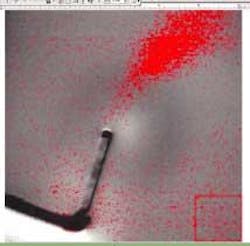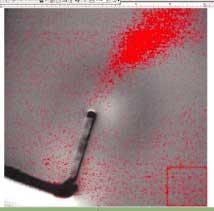Infrared camera spots gas leaks
Vitally interested in developing sensors that can detect gas plumes, the US Missile Defense Agency (MDA; Alexandria; VA; www.mdatechnology.net) awarded a Small Business Innovation Research contract to Pacific Advanced Technology (PAT; Santa Ynez, CA; patinc.com) to build a complete 'smart' camera with an infrared (IR) focal-plane array (FPA) chip providing on-chip nonuniformity correction and image stabilization. PAT's Sherlock gas-leak-detection camera combines the company's Image Multispectral Sensing System (IMSS) or image spectrometer, a cooled 'sensor engine' supplied by Indigo Systems (Goleta, CA; www.indigosystems.com), and a viewer. It checks gas pipelines or refining and processing facilities.
The camera uses the FPA and sensor engine made by Indigo for its Phoenix commercial camera, a 320 × 256-pixel, InSb FPA. PAT developed the electronics and firmware/software to interface with this FPA. The camera detects the presence of methane, propane, or other gas leaks by comparing their spectral signatures against a normal background. Combining camera and host computer, the unit can be hand-held by a technician or mounted in an aircraft.
null
A gas that absorbs IR radiation in the mid-wavelength range (3 to 5 µm) or long-wavelength range (8 to 12 µm) can be detected by the image spectrometer. "The IMSS system scans the wave band (3 to 5 µm) by moving the lens relative to the focal plane. This produces a series of very-narrow-bandwidth images of the scene. A spectrum can be obtained by tracking any point in the image over the series of narrow-band images. In addition, the IMSS can act as a continuous narrow-bandwidth filter or dwell at any wavelength or combination of wavelengths of interest, says PAT's vice president Robert Hinnrichs.
PAT anticipates that production units will be ready this summer at a cost of between $40,000 and $80,000, depending on quantities manufactured. "If the US Environmental Protection Agency (Washington, DC; www.epa.gov) were to accept spectral surveys instead of the current methods that involve physically applying solutions to facility components to find leaks, the market demand for gas-detection cameras would significantly increase," says Hinnrichs.
In a recent test conducted by PAT, the IMSS camera exceeded the goal of detecting and measuring methane leak rates as small as 1 cubic foot per minute (cfm). During operation, the camera imaged gas leaks as small as 0.01 cfm under ambient conditions, using either a building or the sky as a background. Imaging gas leaks with sky backgrounds is important, because reflecting backgrounds are not required as they are in conventional laser-based instruments.
In addition, the IMSS device can be used to image methane leaks, which migrate to the surface from buried tubes. This device may prove useful in detecting leaks from the more than 1 million miles of underground pipelines in US natural-gas production, distribution, and transmission systems.
British Petroleum (London, England; www.bp.com) worked in tandem with the Gas Technology Institute (Des Plaines, IL; www.gri.org) to provide funding and facilities for testing the IMSS camera. Shell Petroleum, NV (The Hague, The Netherlands; www.shell.com) and a Swedish corporation have also expressed interest in this technology, according to Hinnrichs.
CORRECTION
The Technology Trends story "Laser scanner speeds molding process" in the January issue (p. 12) begins with the text on p. 13, "Engineers at Hunt Machine and Manufacturing." We apologize for any confusion this may have caused.

